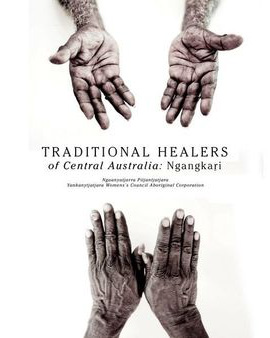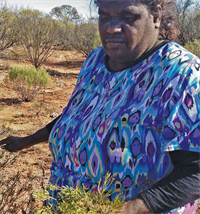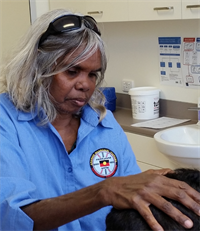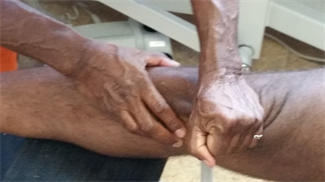Aboriginal and Torres Strait Islander nations have medicine and healing traditions that helped sustain physical and mental health and wellbeing over tens of thousands of years.
Many of these traditions survive into the present day and, as discussed here, there are movements to both integrate these traditions into the contemporary Australian health system and to ensure their survival into the future.
 Within this broader movement, the Aṉangu Ngangkaṟi Tjutaku Aboriginal Corporation (ANTAC) is the first organisation of Aboriginal traditional healers in Australia. ANTAC includes the Ngangkaṟi
healers of the Aṉangu Pitjantjatjara Yankunytjatjara Lands (APY) in the far north-west corner of South Australia, straddling Western Australia and the Northern Territory.
Within this broader movement, the Aṉangu Ngangkaṟi Tjutaku Aboriginal Corporation (ANTAC) is the first organisation of Aboriginal traditional healers in Australia. ANTAC includes the Ngangkaṟi
healers of the Aṉangu Pitjantjatjara Yankunytjatjara Lands (APY) in the far north-west corner of South Australia, straddling Western Australia and the Northern Territory.
The Ngangkaṟi’s work is described in Traditional Healers of Central Australia: Nganagkaṟi1 (published by the NPY Women’s Council an organisation that operates in Alice Springs and in Central desert areas across WA, NT and SA) and ANTAC’s Hand-in-Hand Report on Aboriginal Traditional Medicine2.
It combines ‘hands on’ and breath-based healing practices with the use of traditional plants and balms to heal within an uniquely Indigenous belief system combining physical, emotional, mental and spiritual levels of being and in the context of a spiritual world not recognised in western medical paradigms.

Recently, for example, some Aboriginal women requiring dialysis became sensitive to the presence of a spirit in the dialysis rooms with an Adelaide hospital. This too was cleared by the Ngangkaṟi and so their treatment could proceed.
Dr Francesca Panzironi explains how ANTAC’s aim is to integrate the Aboriginal medicine tradition into Australia’s national healthcare system through the development of a two-way healthcare model that ensures access to the ‘best of both worlds’ in Aboriginal traditional medicine, healing practices and western medicine.
ANTAC has positioned itself in the two-way healthcare model it proposes as a point of connection between the Ngangkaṟi and the mainstream health system. There are two elements to this positioning.
“Ngangkaṟi practices have proven effective not only in physical health contexts but also in addressing grief, depression and mental health challenges which for some Aboriginal people can include working with the spirits of deceased kin or relatives, or spirits in general”
— Dr Francesca Panzironi, founder and CEO of ANTAC
ANTAC first provides a contact point for Indigenous and non-Indigenous people seeking Ngangkaṟi healers and services and promotes access to Ngangkaṟi services. Referrals are directed to ANTAC by SA Health sites including hospitals, health services and clinics and the Ngangkaṟi work through individual healing sessions and clinic scheduled appointments for which they receive remuneration through the brokerage program fund.
 Second, by developing best practice for Ngangkaṟis services delivery including protocols for protecting the Ngangkaṟi from infection while in healthcare settings; how Ngangkaṟi might work best in acute settings; how Ngangkaṟi are recognised. This work involves close work with clinicians and health service staff to ensure all stakeholders are aware of the Ngangkaṟi and how to work with them in a culturally safe, respectful and clinically appropriate way. This can include by ensuring they are accompanied by Aboriginal liaison officers in hospital and other clinical settings, and in settings where their work might be misunderstood or language a potential barrier.
Second, by developing best practice for Ngangkaṟis services delivery including protocols for protecting the Ngangkaṟi from infection while in healthcare settings; how Ngangkaṟi might work best in acute settings; how Ngangkaṟi are recognised. This work involves close work with clinicians and health service staff to ensure all stakeholders are aware of the Ngangkaṟi and how to work with them in a culturally safe, respectful and clinically appropriate way. This can include by ensuring they are accompanied by Aboriginal liaison officers in hospital and other clinical settings, and in settings where their work might be misunderstood or language a potential barrier.
The value of the Ngangkaṟi in health service settings is illustrated by Kurt Towers, Executive Director of the Watto Purrunna Aboriginal Health Service that provides services across four sites in Adelaide’s northern and central metropolitan regions. ‘Watto Purrunna’ is a Kaurna term meaning ‘the branch of life’.
"We really value ANTAC and the Ngangkaṟi services Watto Purrunna can access through them for our clients. In fact, the Ngangkaṟi now provide a regular clinic at all four of our sites across Adelaide. At these, clients can access the Ngangkaṟi with a referral from a clinician — a doctor or an Aboriginal Health Practitioner. But we also respond to direct requests from an Aboriginal person or their family or kin, for treatment.
 "By these referral pathways, we can arrange for Ngangkaṟi to visit people in
emergency departments and hospital settings, aged care settings, alcohol and drug rehabilitation settings, in palliative care, and in mental health clinics. Sometimes our belief systems require the Ngangkaṟi to visit a person’s home in order to treat or heal their entire living environment and even work with their family.
"By these referral pathways, we can arrange for Ngangkaṟi to visit people in
emergency departments and hospital settings, aged care settings, alcohol and drug rehabilitation settings, in palliative care, and in mental health clinics. Sometimes our belief systems require the Ngangkaṟi to visit a person’s home in order to treat or heal their entire living environment and even work with their family.
"I believe we still have a bit more to go in terms of promoting Ngangkaṟi services not just to doctors, health services and the hospital system — but to our Aboriginal patients. I believe that just as it is standard practice for Aboriginal liaison officers to attend to our people in hospital, so too the option for Ngangkaṟi services should also be made available.
"In the Northern Adelaide Local Health Network in which Watto Purrunna
operates, it’s mandatory for all staff to undertake cultural learning, and we use this opportunity to celebrate the role of the Ngangkaṟi. We also have quite a stringent evaluation after every Ngangkaṟi service episode — qualitative and quantitative. We anticipate publishing the results in the near future. What I can confirm for now is that by using our traditional healers, our health system has engaged Indigenous consumers in new ways that have a host of flow on benefits not the least of which being greater use of those services in the first place. Further, that Ngangkaṟi treatments are entirely complimentary to the hospital and western clinical treatments."
— Kurt Towers, Executive Director of the Watto Purrunna Aboriginal Health Service
Find out more about ANTAC at antac.org.au
Download PDF
Read next: Marrabinya: Aboriginal Health in Aboriginal Hands
1 NPY Women’s Council Aboriginal Corporation (2013). Traditional Healers of the Central Desert: Ngangkari. Magabala Books.
2 Panzironi, F. (2013). Hand-in-Hand. Report on Aboriginal Traditional Medicine. Aṉangu Pitjantjatjara
Yankunytjatjara Lands (APY): Aṉangu Ngangkaṟi Tjutaku Aboriginal Corporation.